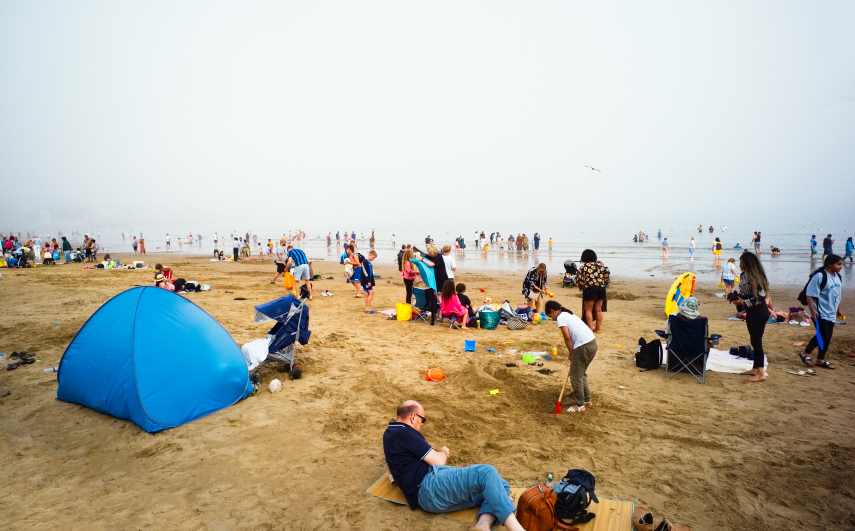Why the Albanian Riviera is perfect for a road trip
This article was produced by National Geographic Traveller (UK).
Running down the country’s southwestern flank, from the city of Vlorë in the north to the village of Ksamil, the Albanian Riviera has been proclaimed the Maldives of Europe. It’s true that countless white-sand beaches dot a coastline of dazzling blue waters, from busy stretches backed by modern resorts to secluded coves. But the Riviera is about more than just the sea; there are traditional villages clinging to hillsides covered by centuries-old olive groves, and ancient ruins alongside remnants of the country’s communist past.
Reaching the area is now easier than ever thanks to an increasing number of direct flights connecting the UK with Albania’s capital, Tirana, a two-hour drive from Vlorë. You can then head south along the SH8, the Riviera’s main coastal road, keeping the glistening Ionian Sea in your peripheral vision almost all the way. The region’s highlights can be explored in a weekend, but stop for longer to discover more of its archaeological treasures and while away unhurried afternoons lounging on its lesser-known beaches.

The shallow waters of Lake Butrint are ideal for harvesting mussels.
Photograph by Alamy, Witold Skrypczak
Morning: Start in Vlorë, Albania’s third-largest city and the birthplace of the modern nation. In Flag’s Square, the Independence Monument stands by the spot where the Albanian flag was first raised in 1912, marking the end of centuries of Ottoman rule. To learn more, head down Boulevard Ismail Qemali, named after Albania’s first prime minister, to the National Museum of Independence, which traces the key events and players behind the country’s self-rule.
Then, drive five miles south along the waterfront, past the point at which the seas shift from Adriatic to Ionian, for lunch at Qendra e Peshkimit in the village of Radhimë. Select from the fresh catch displayed on the front-of-house market stall, and enjoy it overlooking the small harbour.
Afternoon: Walk off your lunch in Llogara National Park, an hour’s drive south of Vlorë. The Caesar’s Pass trail starts outside Hotel Sofo Llogara and follows the route Julius Caesar is said to have taken in pursuit of Pompey, a Roman general and Caesar’s bitter rival. The half-hour climb snakes through pine forest, culminating at a platform with views over the Bay of Vlorë.
The road out of the mountains offers the first sight of the beaches, but resist their temptation and carry on to the bay of Porto Palermo. A fortress, built in 1804 by Ottoman ruler Ali Pasha, guards the entrance to the bay’s natural harbour. Tours take in passageways and gloomy chambers, including a frighteningly dark dungeon.
Evening: Continue heading south for a stroll along the lamp-lit promenade between the bright bars and pebbled beach of Qeparo Fushë village. Sunset Boulevard Cocktail bar mixes exceptional mojitos with local limes and is a great spot in which to watch the sun set beyond the Greek island of Corfu, which lies just west of the Albanian coast.
A short drive into the hills leads to the village of Qeparo Fshat, which presents a more traditional way of life. After the fall of communism, it shrunk, but its heart remains intact. At Ida & Xhorxhi Restaurant, Ida Thanasi knocks out whatever’s fresh and seasonal for diners to eat on the vine-covered verandah, while husband Xhorxhi serves shots of raki out front.

From the city of Vlorë in the north to the village of Ksamil, the Albanian Riviera has been proclaimed the Maldives of Europe.
Photograph by Getty Images, Nejc Gostincar
Morning: After a breakfast of fluffy petulla (fried dough fritters) and Turkish coffee back at Ida & Xhorxhi Restaurant, wander the steep lanes of Qeparo Fshat. Many of the rundown houses are being rebuilt using materials reclaimed from other abandoned properties, to preserve the village’s original aesthetic. Alleyways lead to panoramic viewpoints, overlooking either the coast or mountain valleys.
Get back on the SH8, hugging the hillsides above the sea, before turning onto an unpaved track (immediately before the ‘Lukove’ road sign) leading to Buneci Beach. The gentle waters here are ideal for plunging into from the stone jetty, or exploring via kayak or standup paddleboard (rentals are available from the middle of the beach).
Afternoon: Follow the track along Buneci as far south as it will go for a lunch of grilled sea bream under the straw roof of Taverna Nikolas. Then, divert away from the coast to the Blue Eye spring. It bubbles up from deep below the Bistricë river, creating an iris-like dark pool within the blue-green of the shallower surrounds. Once, only former dictator Enver Hoxha and senior Communist Party officials were permitted to visit, but it’s now one of Albania’s more popular sites (expect it to get busy in summer). A 20-minute walk from the car park leads to an observation deck giving the best views down into the abyss. Swimming in the Blue Eye isn’t permitted, but you can brave the bracingly cold river just a short walk downstream.
Evening: Return towards the coast, making for Lake Butrint. Its shallow, brackish waters are perfect for growing mussels, and farmer Soraldo Nebo runs boat tours to demonstrate how the shellfish has been harvested here for centuries. Afterwards, watch him prepare the molluscs — steamed in a garlic broth, or salted and grilled — and put some to the test, accompanied by a glass of Albanian white wine.
See out the day a half-hour drive away on the private beach of Kep Merli resort, hidden away on the fringes of busy Ksamil village. Only a strict number of day visitors are allowed at the beach bar; book ahead to sip cocktails lounging on the softest sand of the Riviera.

Over 2,500 years of history are layered over the ancient city of Butrint, a UNESCO World Heritage Site at the southern end of the Riviera
Photograph by Getty Images, Master2
Orikum
On the road to Orikum, at the southern end of the Bay of Vlorë, there’s little to suggest a historical site lies just ahead. Fragments of communist-era bunkers pile up at the roadside, repurposed as coastal defences; horses graze near abandoned barracks. But that’s quickly forgotten as you turn into the park, once an important trading port, where successive empires have left their mark since the sixth century. Crumbling blocks of a Hellenistic harbour sink into the lagoon, backed by perimeter walls reinforced during the Byzantine era. Hillside paths link Roman houses to a Greek theatre. Even Julius Caesar was here in 48 BCE, overseeing the post during his civil war campaign against Pompey.
Finiq
Occupying a hilltop position close to the city of Sarandë, overlooking the surrounding valleys and plains, Finiq was a major centre of the ancient Greek kingdom of Epirus. It sees fewer visitors than other archaeological parks in the area, but it’s blessed with natural beauty, with a blanket of wildflowers blooming yellow, pink, white and blue among the ancient blocks. A curving Hellenistic theatre sits within a fold of the hill, once perfectly positioned acoustically; today, it echoes the clang of goat bells across the valleys. Contrasting with the remnants of antiquity, a small complex of communist-era bunkers, connected by a network of tunnels, makes for an interesting subterranean scramble.
Butrint
Over 2,500 years of history are layered over this ancient city, a UNESCO World Heritage Site at the southern end of the Riviera. As is the case with Orikum, invading empires built on top of what had stood before, creating a mix of cultures and styles. Ancient Greek, Roman, Byzantine and Venetian buildings are all scattered within the enormous limestone perimeter walls, with more being unearthed every year. At its peak, as many as 16,000 people lived here, making use of Roman baths, a forum and a nymphaeum (structures dedicated to nymphs). Most impressive are the remains of the Roman aqueduct, which once extended far across Lake Butrint, bringing spring water from distant hills.
Published in the July/August 2025 issue of National Geographic Traveller (UK).
To subscribe to National Geographic Traveller (UK) magazine click here. (Available in select countries only).












